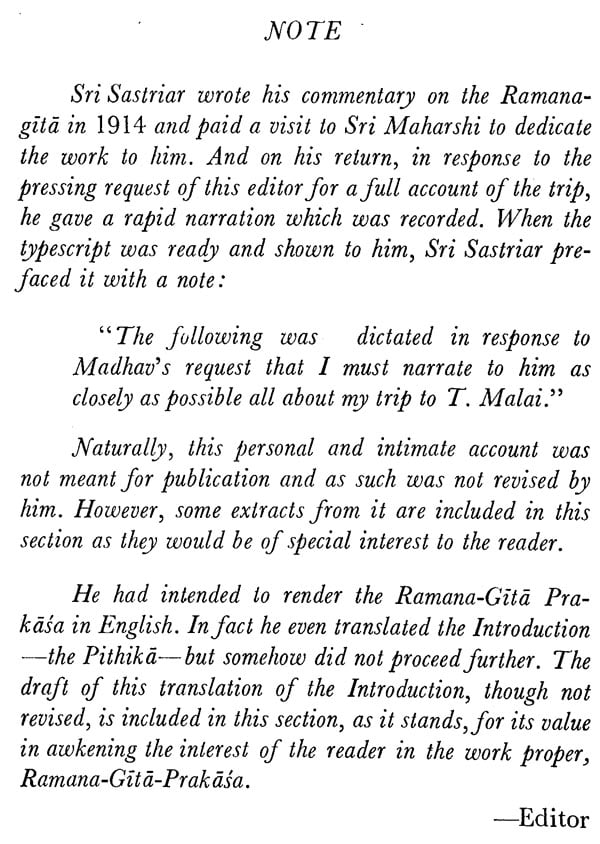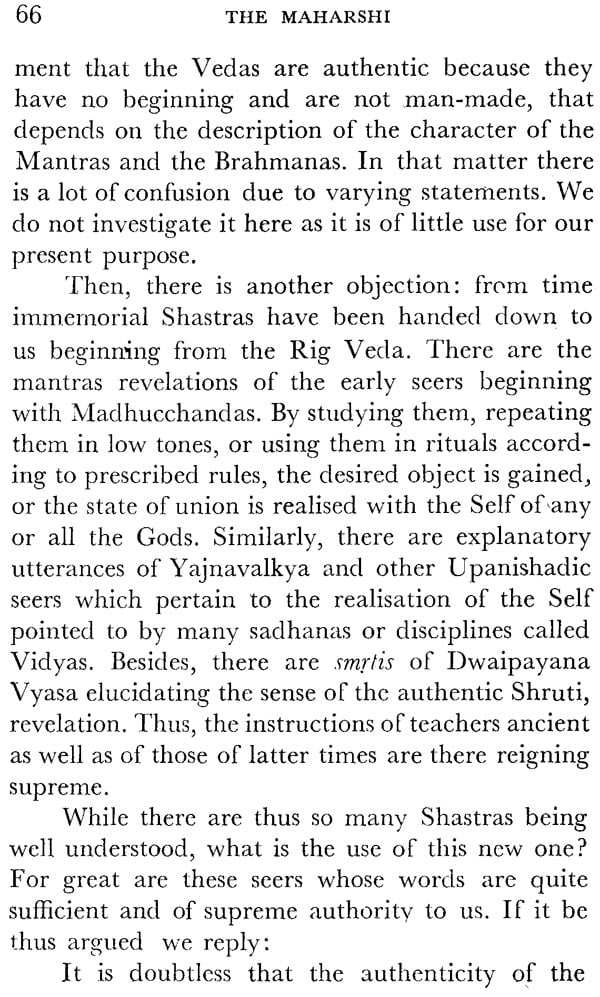
The Maharshi
Book Specification
| Item Code: | IDI660 |
| Author: | T. V. Kapali Sastry |
| Publisher: | V. S. Ramanan, Tiruvannamalai |
| Edition: | 1955 |
| Pages: | 96 (B & W Illus: 1) |
| Cover: | Paperback |
| Other Details | 6.9"X 4.6 |
| Weight | 100 gm |
Book Description
Editor's Note
This Volume is compiled from among the papers of Sri Kapali Sastriar. The first section consists of articles written, now two decades ago, on special occasions at the Ashram of Sri Bhagavan Ramana Maharshi. These and most of the portions of the third section appeared originally in the Sunday Times. The contents of the second section are being published for the first time. A Poem, Sri Raman-Anjali, hitherto unpublished, is prefixed to the collection along with an English translation. The rendering was done by our esteemed friend Prof. A. R. Ponnuswami Iyer whose Foreword presents the work is appropriate setting.
Foreword
It is not the purpose of this Foreword either to commend the book or to recommend it to the public. The first would form an act of impertinence and the second an act of superarrogation. Its victory and prosperity wait upon the combination Yatra yogeswarah krsnah Yatra partho dhanurdharah. So where the theme is Bhagavan Sri Maharshi to the writer, there is bound to be feast of intellect and flow of soul. I write merely to express my own personal satisfaction that these fragmentary writings of Sri Sastriar found scattered in periodicals and private diaries are here brought together and presented to the world.
It is needless to point out the unique qualifications of Sri Sastriar for interpreting Sri Maharshi's personality and teachings. He first came into the circle of Sri Maharshi's light in 1911, as a disciple of Sri Kavyakantha Ganapati Sastrigal, the foremost of Sri Maharshi's disciples at the time. By the ripeness of his soul, which had been mellowed by years of previous Sadhana, he soon came closer to an understanding of Sri Maharshi's Upadesha - (Sat Darsana and Hrdaya Vidya) than anyone else. Even after, under the imperative urge of an inner development, he took the Sadhana of Sri Aurobindo; he retained his reverential attachment to Sri Maharshi. This he could do without sacrifice of principle or compromise with conscience for he saw, appreciated and assimilated the realized truth that these two greatest teachers of the age have given to the world. Small men, with their little egos, boast of their teachers, as they boast of their material possessions, feel needless jealousies, and stir up passion and discord in a realm where harmony should reign. But Sri Sastriar could be loyal to Sri Aurobindo without being disloyal to Sri Maharshi or his still earlier guru Sri Ganapati Sastrigal.
It is not without significance that Sri Kapali Sastriar's outstanding contributions to the propagation of Sri Maharshi's teachings, Sat Darsana Bhasya and its English rendering, and the Ramana Gita Prakasa were written after he had definitely accepted Sri Aurobindo's philosophy and adopted his Sadhana. It shows his reverence for those authentic utterances of Sri Maharshi's message and his feeling that their pregnant teachings should be expounded through commentaries in the traditional style. Critics who would like to fit Sri Maharshi's teachings neatly into the frame work of a previous system may disagree here and there with Sri Sastriar's exposition, but Sri Kapali Sastriar had the benefit of direct instruction from Sri Maharshi and his commentaries were submitted to Bhagavan and were accepted by him. It has to be remembered that Sri Maharshi is not a system-builder but a seer and his words are revelatory and not expository. Naturally, as in the case of the pregnant utterances of the Upanishads, even in his time, there emerged different interpretations of his philosophy. There is no need to question the bonafides of any commentator. But it will be conceded that Sri Sastriar brought to the work a combination of qualifications equaled by none and approached by few learning, intuition and initiation. It could be claimed for his that for everything he wrote he had authority-na amulam likhyate kincit. In the precious Talks prefixed to Sri Sastriar's rendering of Sat Darsana Bhasya, pointed questions are put to Sri Maharshi on difficult point of doctrine of Sadhana and his clear and trenchant answers are recorded. The Bhashya is an elaboration of those answers. One of the most luminous chapters in the Ramana Gita also contains Sri Maharshi's answers to Sri Sastriar's significant questions. We may be sure that Sri Maharshi's feeling towards Sri Sastriar was not unlike that of Yama to Nachiketas (in Katha Upanishad) when he exclaims "Truly thou art steadfast in the Truth. Even such a questioner as thou art May I meet with always." The relation between the two may be summed up in the words of the same Upanishad. "A miracle is the man that can speak of Him wisely or is skilful to win Him, and when one is found, a miracle is the listener who can know Him even when taught of Him by the knower."
| Foreword | 1 | |
| Anjali To Sri Ramana | 6 | |
| | ||
| I. | The Maharshi And His | |
| Central Teaching | 17 | |
| II. | The Significance Of Mahapooja | 24 |
| III. | Vasishtha Ganapati Muni: | |
| The Gurugita | 32 | |
| | ||
| I. | Dedication Of Ramana-Gita-Prakasha | 42 |
| II. | Introduction To | |
| Ramana-Gita-Prakasha | 60 | |
| | ||
| Leaves From A Diary | 77 | |
| Appendix | 93 |









